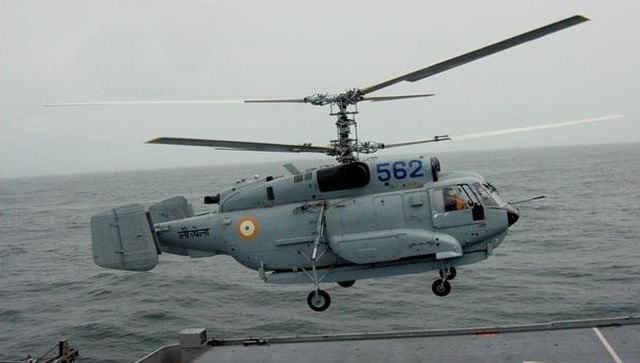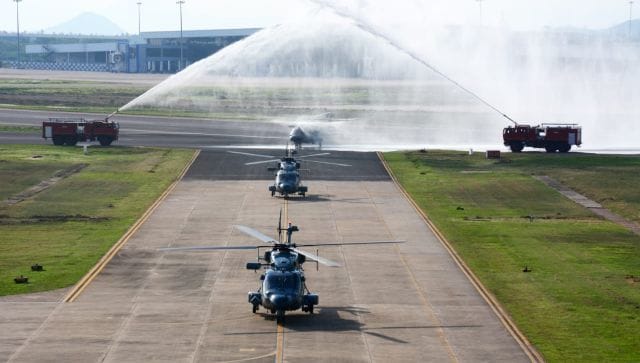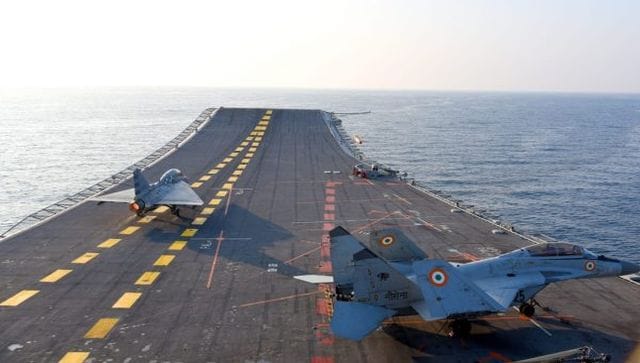‘A Floating Airbase’: MiG-29K Fighter Jets, Other Helicopters Which Will Be Part of Ins Vikrant’s Airwing

The Russia-origin MiG-29K will be the main arsenal of the aircraft carrier INS Vikrant. The warship’s airwing will also boast of Kamov-31 helicopters, the US-origin MH-60R multi-role helicopters and the homegrown Advanced Light Helicopters (ALH) and Light Combat Aircraft (LCA) TEJAS-Navy
It’s one giant leap toward self-reliance in the defence sector. INS Vikrant, the first made-India aircraft, was commissioned by Prime Minister Narendra Modi on Friday.
The 45,000-ton warship has been built at the cost of Rs 20,000 crore. At 262 metres long and 62 metres wide, it is the largest warship to be built in India.
“Today, here on the coast of Kerala, every Indian is witnessing the sunrise of a new future. This event held on INS Vikrant is a tribute to India’s rising spirits on the world horizon,” Modi said at grand ceremony at Cochin Shipyard in Kerala on Friday.
“Vikrant is huge and special. Vikrant is not just a warship. This is a testimony to the hard work, talent, influence and commitment of 21st century India,” he added.
Prime Minister Narendra Modi commissioned INS Vikrant, India’s first homemade aircraft carrier. He said the warship is a “testimony to the hard work, talent, influence and commitment of 21st century India.”
With INS Vikrant, India has joined a select group of nations that can indigenously design and build an aircraft carrier. The 18-floor high ship has about 2,400 compartments and can accommodate a crew of 1,600. It has a 16-bed hospital, a well-equipped kitchen and a unit that can make 3,000 Rotis an hour.
But most importantly when operational, the warship will act as a floating airbase in the ocean. The aviation hangar is as big as two Olympic-size pools that can accommodate around 20 aircraft.
The carrier will have an airwing comprising Russia-origin MiG-29K fighter jets, airborne early-warning control helicopter Kamov-31 helicopters, and the US-origin MH-60R multi-role helicopters along with the homegrown Advanced Light Helicopters (ALH) and Light Combat Aircraft (LCA) TEJAS-Navy.
We take a look at its arsenal and what it can do.
MiG-29K
The main arsenal of INS Vikrant is the Russia-origin MiG-29K. A state-of-the-art, all-weather air-dominance fighter jet, it is specially built for the Indian Navy.
The aircraft has a maximum speed over twice the speed of sound (about 2000 kmph), can pull up to eight times the force of gravity and climb to an altitude of over 65000 feet, according to the Indian Navy website.
The MiG-29K squadron is christened INAS 303 and is popularly referred to as the “Black Panthers”. Image courtesy: Indian Navy
Armed with sophisticated weapons, the MiG-29K is fully equipped to engage targets in the air, at sea or on land. With air-to-air refuelling capability, it can fly a long range to carry out important missions.
“The MiG-29K is a true swing role aircraft which carries enough punch to undertake air dominance and power projection missions simultaneously, bestowing the commander at sea, great flexibility. It takes Indian naval aviation from a defensive stature to one of dominance,” the Indian Navy says on its website.
The jets were inducted by AK Antony on 19 February 2020 when he was a defence minister in the United Progressive Alliance (UPA) government.
The MiG-29K squadron is christened INAS-303 and is popularly referred to as “Black Panthers”. It marked a new era of fighter flying in the Indian Navy and hence was called a “game-changer”. The squadron has its base in INS Hansa in Goa.
Kamov-31 Helicopters
Originally developed for the Soviet navy, these helicopters are currently in service in India, Russia, and China.
Kamov-31 airborne early warning (AEW) helicopters were inducted in the Indian Navy in 2003. Their main mission is long-range detection and naval threats. They can track targets over a much larger horizon than the ship’s radar.

These helicopters were developed for the Soviet navy and now serve India, China, and Russia. Image courtesy: Indian Navy
The helicopters are fitted with airborne electronic warfare radar, which can simultaneously track up to 40 airborne or surface threats, detect fighter-sized aircraft from a range of 100 to 200 km, and surface ships at a horizon of 200 km from an altitude of 9840 feet.
MH-60R Multi-Role Helicopters
The US-origin MH-60 R multirole helicopters are part of the INS Vikrant’s airwing.

Called Romeo, MH-60 R multirole helicopters are manufactured by Lockheed Martin
The MH-60R is the most advanced marine multi-mission helicopter currently in use. Manufactured by Lockheed Martin Corporation, it is an all-weather helicopter. Called “Romeo”, these copters help boost the Indian Navy’s anti-submarine warfare capability. They are deployed in a range of roles including anti-ship strikes, specialised maritime operations and search and rescue missions.
In July 2002, the Indian Navy received two MH-60 R multirole helicopters from the United States. The delivery of all 24 MH 60 R helicopters will be completed by 2025.
Dhruv ALH MK III
The homegrown Dhruv Advanced Light Helicopter MK III is part of INS Vikrant’s arsenal. Made by the Centre-run Hindustan Aeronautics Limited, three helicopters were inducted in the Indian Navy in June last year.

The homegrown Dhruv MK-III Helicopter is used for maritime surveillance and coastal security
They are used for maritime surveillance and coastal security. The DHRUV MK-III helicopters feature an array of systems previously seen only on heavier, multi-role helicopters of the Indian Navy. They are fitted with modern surveillance radar and electro-optical equipment, which enable them to undertake the role of maritime reconnaissance in addition to providing long-range search and rescue, both by day and night, according to the Indian Navy.
In addition to special operations capabilities, DHRUV MK-III is also fitted with a heavy machine gun to undertake constabulary missions. A removable medical intensive care unit (ICU) is also fitted on the helicopters to airlift critically ill patients.
TEJAS (Navy)

The naval version of the Tejas Light Combat Aircraft (LCA) is part of the INS Vikrant airwing
The naval version of the Tejas Light Combat Aircraft (LCA) is part of the fleet. It is a fourth-generation fighter with critical operational capabilities that include an Active Electronically-Scanned Array (AESA) radar, an Electronic Warfare (EW) suite, and is capable of air-to-air refuelling (AAR).
It can carry the same array of modern weapons that can be loaded on bigger warplanes, for example, precision-guided and standoff weaponry to long-range beyond visual range missiles that can take down target planes from a safe distance.
Now that the warship is commissioned, the deck integration trials of fixed-wing aircraft and exploitation of the Aviation Facility Complex will be carried. The operational command and control of the ship, including flight safety, is with the Indian Navy, according to a report in The Indian Express.
The flight trials of INS Vikrant are set to begin by November and the carrier is expected to be fully operational by mid-2023.



No comments:
Post a Comment